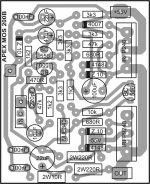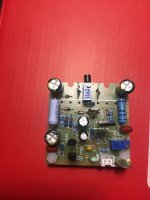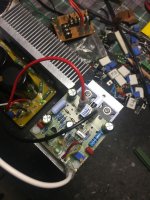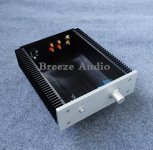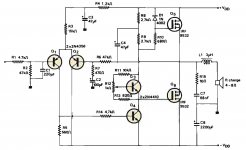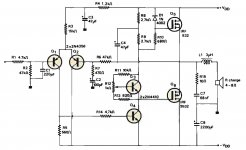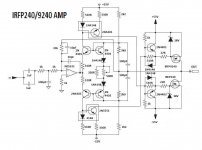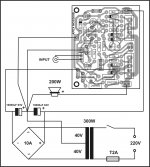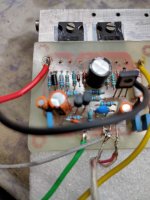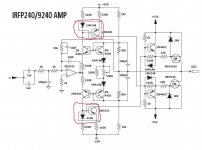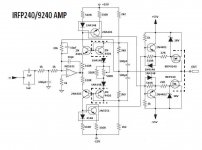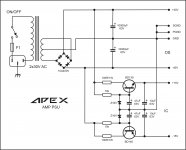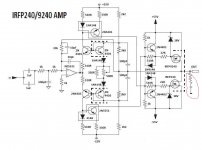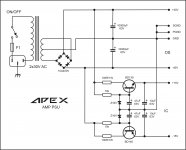Attached is a comparison of a few common constant current circuits. If the bjt circuits have a constant bias source, then the first two bjt are the best and reach the regulation current with only a couple volts, but we are concerned about supply ramp-up where the bias is also ramping up.
The Jfet circuits do not require any bias current and perform well, the two JFET circuit being a bit more flat but more complicated. I would go with the single Jfet circuit.
The LED circuit is just poor.
Hi Steveu,
My diy Elliott P3A has a LED CCS
Thanks for the CCS data: the coming lockdown weekend is now planned
Cheers,
Jacques
MOS200II
I use 55v DC, everything is the same as the schematic diagram, only changed two resistors to variable resistors, one is c-pole 470r, the other is bias 1.2k. I don't know why the simulation program can't get the correct bias and operation effect, but the real object can adjust the bias. I don't have 1n4740, I replace it with 12V 1n4742, but it will cause problems. In the input BC556, there will be a current of 3.5ma, which will be a little hot, I'll change it to 1n4740 or change the resistance value of 3.3k in the future to find a way to eliminate the slight rustling sound. The bass is very good. It doesn't need a fan. It can be installed in a 190mmx54mmx246 ultra-small chassis
I use 55v DC, everything is the same as the schematic diagram, only changed two resistors to variable resistors, one is c-pole 470r, the other is bias 1.2k. I don't know why the simulation program can't get the correct bias and operation effect, but the real object can adjust the bias. I don't have 1n4740, I replace it with 12V 1n4742, but it will cause problems. In the input BC556, there will be a current of 3.5ma, which will be a little hot, I'll change it to 1n4740 or change the resistance value of 3.3k in the future to find a way to eliminate the slight rustling sound. The bass is very good. It doesn't need a fan. It can be installed in a 190mmx54mmx246 ultra-small chassis
Attachments
IRF Hexfets are notoriously hard to temp stabilize, plus they require lots of bias current and feedback to obtain low THD due to their non linear properties. Lateral fets are superior in comparison.
I bought a whole bunch of 2SJ56/2SK176 back when Hafler sold off their remaining supply which they used in most of their larger amps (my XL600 has these). Lateral fets are the preferred mosfets to use in a power amp. The IRF hexfets just don't like to behave well thermally when put into their best linear operating area for lowest THD. Underbiasing them sounds pretty bad, but thats the only way they live predictably long in a high powered class AB amp.
I wish there was a better substitute for those obsolete Hitachi lateral fets. Their drawback was the P channel was always weaker than the approximate complementary N channel device. Gate capacitance and transconductance was also very different, so you had to deal with that in the output stage with mismatched parts. Even so, they managed to sound very musical to my ears. Now there are better BJT designs which tend to sound more refined IMO. I retired my Hafler XL600 when I listened to a Parasound A21, which combines the best of both worlds - fet input and driver stages with modern BJT output stages. John Curl is a brilliant audio designer.
I bought a whole bunch of 2SJ56/2SK176 back when Hafler sold off their remaining supply which they used in most of their larger amps (my XL600 has these). Lateral fets are the preferred mosfets to use in a power amp. The IRF hexfets just don't like to behave well thermally when put into their best linear operating area for lowest THD. Underbiasing them sounds pretty bad, but thats the only way they live predictably long in a high powered class AB amp.
I wish there was a better substitute for those obsolete Hitachi lateral fets. Their drawback was the P channel was always weaker than the approximate complementary N channel device. Gate capacitance and transconductance was also very different, so you had to deal with that in the output stage with mismatched parts. Even so, they managed to sound very musical to my ears. Now there are better BJT designs which tend to sound more refined IMO. I retired my Hafler XL600 when I listened to a Parasound A21, which combines the best of both worlds - fet input and driver stages with modern BJT output stages. John Curl is a brilliant audio designer.
I wish there was a better substitute for those obsolete Hitachi lateral fets.
You know about Exicon, right?
Hafler DH-200/220 Mods
IRFP240/9240 Amp
Hi. Love that schematic. It's so 90s in a good way. Did you build it already? Compared to other op amp schematic, which work in that way, it doesn't depend on the supply current of the op amp, or does it?
You know about Exicon, right?
Profusion stock Exicon.
About £10 for 8 amp devices and a couple of GBP more for the higher current types.
Hi. Love that schematic. It's so 90s in a good way. Did you build it already? Compared to other op amp schematic, which work in that way, it doesn't depend on the supply current of the op amp, or does it?
It doesn't depend on the supply current of the op amp and it does rail to rail output voltage.
IRFP240/9240 Amp
Hi Mr. Mile, those components should be in fisical contact?. About bias wich component should be in main heatsink.
Pozdrav
Attachments
Hi Mr. Mile, those components should be in fisical contact?. About bias wich component should be in main heatsink.
Pozdrav
Yes...
Attachments
Yes...
Thanks Mr. Mile for your reply. In order to get +-15VDC what should I do.
Pozdrav
Thanks Mr. Mile for your reply. In order to get +-15VDC what should I do.
Pozdrav
Use this PSU circuit...
Attachments
Last edited:
- Home
- Amplifiers
- Solid State
- MOSFET Amplifier IRFP240/IRFP9240
